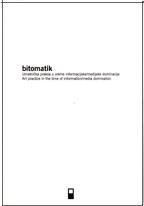kuda.org (eds.): bitomatik: Art Practice in the Time of Information/Media Domination (2004) [English/Serbian]
Filed under book | Tags: · capitalism, computer art, floss, internet, media theory, networks, software art, wireless networks

“bitomatik is a collection of texts, transcripts of lectures held at the New Media Center kuda.org between 2001 and 2004. The texts describe models of comtemporary artistic production which use different media as a means of expression. Drawing on the activist-artistic practice of Novi Sad in the sixties and seventies, a period of the neo-avant garde, the kuda.org Center has examined those phenomena containing an interdisciplinary and cross-media character. From the very outset, kuda.lounge has been a platform for discussion, argumentation, dialog and the contextualization of artistic practice, in the framework of which more than fifty presentations, lectures and workshops have been organized. Particular attention has been paid to communication and the exchange of ideas, primarily owing to the fact that the arts’ scene in Serbia during the nineties developed within a context of what is often called ‘Art in a Closed Society’, which resulted in a syndrome of self-referential artistic production. The Internet and the development of communication technologies formed the electronic backbone of social movements in the late nineties and the early part of this new century, and at the same time connected a smaller circle of Novi Sad artists (the Absolutely Association, Andrej Tišma, the Videomedia festival) which in spite of the odds established contact with the international scene, and brought members of this network to present their work in Novi Sad. International mailing lists such as Nettime, Syndicate and Spectre played a central role in this communication.
In inviting key names in media art and theory, kuda.org has attempted to offer the local public an insight into international contemporary artistic practise. The local population has had a chance to familiarize themselves with the work of leading international and local artists, theoreticians and arts’ groups such as Critical Art Ensemble, Bureau d’Etudes, Armin Medosch, and Inke Arns. Lectures and presentations within the framework of kuda.lounge are orientated towards researching new media related to social activism, media theory, and conceptual art, new-media “genres” such as net.art, software art, interactive art and generative art are explored .
The question of the so-called new media is quantitively identical to problems dealt with by the neo-avant-garde of the sixties and seventies, which conducted experiments with installations and video and electronic sound. These problems deal with the question of the relationship between medium and content, i.e. what’s new in new media. Media research is the history of researching communcation and extroversion and in itself simultaneously bears the political, seeking channels to address the masses and send a message. The avant-garde’s aspiration to penetrate society, to reach ground zero, and lead it in the utopian project of creating a fair society is closely connected to media research. The contents of this collection present different research and experiments in new media and a kind of manifestation of the artistic avant-garde at the close of the 20th century and the dawn of the 21st century.
These two elements; society as an object of intervention by an artistic project, and media research via which this intervention is to be carried out, are the basis of this collection of texts. This publication brings a cycle integrating debates and discussions on contemporary artistic practice to a close, and in a print medium presents them to a wider public.”
Contributions by Eric Kluitenberg, Darko Fritz, Armin Medosch, Inke Arns, Critical Art Ensemble, Bureau d’Etudes, and Raqs Media Collective.
Serbian title: bitomatik: Umetnička praksa u vreme informacijske/medijske dominacije
Publisher: Futura publikacije, Novi Sad, 2004
kuda.read series, 2
Creative Commons BY-NC-SA 1.0 License
ISBN 8671880273
168 pages
PDF, PDF (updated on 2021-12-11)
Comment (0)Richard Coyne: The Tuning of Place: Sociable Spaces and Pervasive Digital Media (2010)
Filed under book | Tags: · culture jamming, facebook, gps, locative media, mobile technology, networks, pervasive media, rfid, ubiquitous computing, wireless networks

How do pervasive digital devices—smartphones, iPods, GPS navigation systems, and cameras, among others—influence the way we use spaces? In The Tuning of Place, Richard Coyne argues that these ubiquitous devices and the networks that support them become the means of making incremental adjustments within spaces—of tuning place. Pervasive media help us formulate a sense of place, writes Coyne, through their capacity to introduce small changes, in the same way that tuning a musical instrument invokes the subtle process of recalibration. Places are inhabited spaces, populated by people, their concerns, memories, stories, conversations, encounters, and artifacts. The tuning of place—whereby people use their devices in their interactions with one another—is also a tuning of social relations.
The range of ubiquity is vast—from the familiar phones and handheld devices through RFID tags, smart badges, dynamic signage, microprocessors in cars and kitchen appliances, wearable computing, and prosthetics, to devices still in development. Rather than catalog achievements and predictions, Coyne offers a theoretical framework for discussing pervasive media that can inform developers, designers, and users as they contemplate interventions into the environment. Processes of tuning can lead to consideration of themes highly relevant to pervasive computing: intervention, calibration, wedges, habits, rhythm, tags, taps, tactics, thresholds, aggregation, noise, and interference.
Publisher MIT Press, 2010
ISBN 0262013916, 9780262013918
344 pages
PDF (updated on 2013-2-6)
Comment (0)Theodore S. Rappaport: Wireless Communications: Principles and Practice (1996/2002)
Filed under book | Tags: · technology, wireless networks

Offering a wealth of practical information on the implementation realities of wireless communications, this book also contains up-to-date information on the major wireless communication standards from around the world. Covers every fundamental aspect of wireless communications, from cellular system design to networking, plus the world-wide standards.
Publisher Prentice Hall PTR, 1996
Prentice Hall communications engineering and emerging technologies series
ISBN 0133755363, 9780133755367
Length 641 pages
PDF (no OCR)
Download via Sharebee (no OCR)

